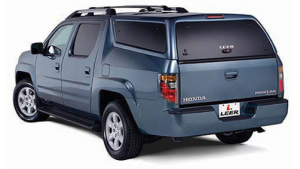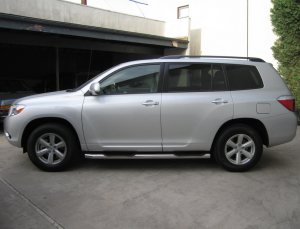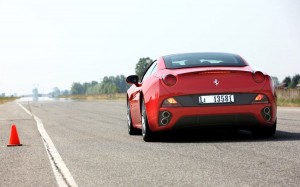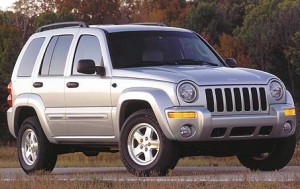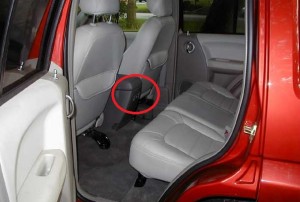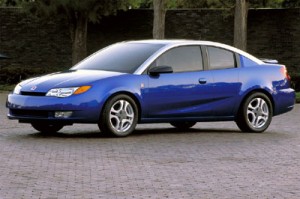Honda Ridgeline Camper Top: Feature Fail
Posted by Doug DeMuro in Feature Fail on | 19 comments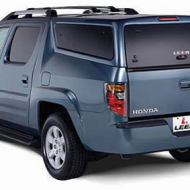
It recently came to my attention that the Honda Ridgeline is still on sale. I found this out quite by accident, when I discovered an article that talked in detail about how Honda plans to keep selling it for another year or two, then cancel it for a while, then maybe replace it, or maybe not. This is the Honda way.
So I had the Ridgeline on my mind, which is why I’ve decided to devote today’s “Feature Fail” column to one of the most unusual features currently available: the Honda Ridgeline camper top.
What is the Honda Ridgeline camper top, you ask? Why, it’s a camper top for a Honda Ridgeline.
And that, in itself, is rather ridiculous. The Ridgeline, for those who are (blissfully, believe me) unaware, is a rather odd-looking pickup truck that uses the running gear from a Honda Pilot, the engine from a Honda Pilot, the transmission from a Honda Pilot, and the platform of a Honda Pilot. In fact, the only way it differs from a Pilot is that it’s open in the back, like a truck, rather than enclosed, like an SUV.
So then why would you pay actual money to close up the back?
Every time I see a Ridgeline with a camper top, which admittedly is not very often, I always wonder about this. You chose the most SUV-like pickup in the world. Then you decided to turn it into an SUV. Why didn’t you just buy an SUV?!
This question is even more confounding when you bring cost into the equation. The Ridgeline and Pilot have the same starting price, meaning you’ve paid strong money to get that truck. Then you’ve paid even more to enclose it!
I don’t understand it, but perhaps you can shed some light. Until then, the Ridgeline camper shell is a feature fail.
Feature Fail: Running Boards
Posted by Doug DeMuro in Feature Fail on | 14 comments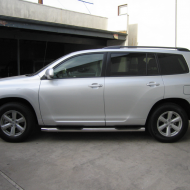
I’ve recently decided on the automotive low point of the last 20 years. No, I’m not referring to the Suzuki X-90, although it certainly earns an honorable mention. I’m not even talking about the Pontiac Aztek. Instead, I’m referring to running boards.
I believe there are two major reasons why running boards are a “feature fail,” and I’ll cover them both. They are:
1. They’re really ugly. I don’t mean slightly ugly, like the BMW 5-Series GT, or even very ugly, like those steel wheels they used on the original Honda CR-V. I mean truly, insanely, unattractive.
When I bought my SUV, I specifically ordered it without running boards for this reason. Of course, I bought used, so when I say I “ordered it,” what I really mean is that I went to CarMax and said I wanted a vehicle that hasn’t even been in the same room as one with running boards.
Now, you’re thinking: Yes, they’re ugly. But they serve a purpose! And so we move on to…
2. They serve no purpose. Here’s what I’ve discovered about running boards. They would be very useful in some taller vehicles if they stuck out about a foot or two from the body, like actual stairs. But obviously they can’t, because this would make the vehicle way too wide for normal roads. So instead they stick out maybe two inches, which is nowhere near wide enough for a human being to put a foot on.
As a result, they have never actually been used, except on old cars from the early 1900s where the width of your running board was an expression of wealth, much in the same way that a window-mounted oval sticker is today.
The lone exception to this is those power-operated running boards on the Lincoln Navigator and Ford Expedition. They come out far enough, and they stow when the vehicle is moving so you can’t see them. They aren’t a feature fail. The rest of the running board industry very much is.
Ferrari California Brake Lights: Feature Fail
Posted by Doug DeMuro in Feature Fail on | 13 comments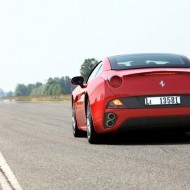
I’ve always liked the Ferrari California. Why? For one, it drives like a Ferrari. Seriously: it’s small, it’s quick and the handling and suspension are tuned precisely as you’d expect from a Ferrari, which is to say that it’s a lot like a Lamborghini or a Porsche but you believe it’s way better because it has a Ferrari badge.
It also sounds like a Ferrari. Even with the stock exhaust, jamming the throttle on the California unleashes exactly the sound you want from Italy’s finest. This seems counterintuitive considering the California is a front-engined four-seater, but it’s true. For proof, just ask a California driver to rev the engine at a traffic light, presuming you can get her to stop applying makeup.
And then there’s the styling. You’ll note I didn’t say I love the California.
I don’t mind the styling too much, save for the rear end. It’s way to big and it’s separated into levels as if it were a condo complex. But the worst part is by far the brake lights.
You see, Ferrari designed the car with the idea of making brake lights out of the circles. But somewhere along the way, Ferrari North America reminded them that brake lights, by federal law, cannot be on a movable body part. Since the circles are mounted on the rear decklid, they wouldn’t work.
This sent Ferrari scrambling back to the drawing board, which was probably an actual drawing board, where they came up with the idea you see in the attached photo. Yes, that’s right: the circles don’t light up. Instead, the tiny little lights right above the exhaust light up. They’re not LED, their brightness varies widely (in the photo, the left one is brighter) and because they’re not the circles, people always think the California’s brake lights are out.
They’re not. It’s just bad design on an otherwise likeable – and not lovable – car.
Feature Fail: Chrysler Power Windows
Posted by Doug DeMuro in Feature Fail on | 17 comments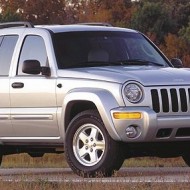
There are few things in the automotive industry more comical than early-2000s Chrysler cost-cutting. Virtually every car the brand released at the time includes at least a few items where Chrysler trimmed a few pennies on the theory that “they’ll never notice this!”
Examples, therefore, are easy to find. But no example is as egregious as power windows on the Dodge Neon and Jeep Liberty.
The Neon is the best of the two. In order to make the car as cheap as possible – which would then become even cheaper with legendary incentives – Chrysler didn’t offer power rear windows on the Neon. But here’s the ridiculous bit: it did offer power front windows. So no matter how much money you spent on a Neon (including the high-performance Neon SRT-4), there was absolutely no way to get your rear windows to roll down with anything other than a manual crank.
With the 2002 Liberty, Jeep realized it couldn’t get away with not offering power windows. So it did the next best thing from the brand’s clearly influential cost-cutting department: it placed the switches on the center console.
This is actually worse than it sounds. In front, the Liberty had four window switches mounted in between the seats. That’s fairly normal for a lot of automakers who are too cheap to do two window setups for right- and left-hand-drive cars. But in back, Jeep said “screw the doors!” and put two more unlit and unmarked window switches at the base of the center storage bin. That meant if you wanted to roll your window down, you had to hunch forward and feel around in the dark until you grabbed the switch. Here’s my question: how much more would it have cost to relocate the switches to the doors?
Really, it’s a wonder Chrysler went into bankruptcy.
Feature Fail: Saturn Ion Roof Rails
Posted by Doug DeMuro in Feature Fail on | 1 comment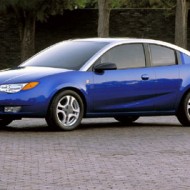
Ahh, the Saturn Ion. Possibly the best example of taking something that already wasn’t very good and making it much, much worse. Hardly a worthy successor to the mediocre S-Series models, the Ion represented the very end of the line for “unique” Saturn products, as everything that came after had a twin somewhere else in the automaker’s dominion.
But while the Ion was bad, its roof rails were even worse.
When the Ion was launched in 2003, it offered interchangeable roof rails that could be ordered in various colors to suit your mood. The press cars were all blue with silver roof rails and four-spoke wheels, which were tremendously unsuited to anything except a really cheap Saturn.
Unfortunately, the Ion wasn’t a really cheap Saturn: an Ion 3 with the roof rails cost around $17,000 with shipping. Back then, you could (barely) get a Toyota Camry for that. The Ion also had a rather dull 2.2-liter engine, and, most importantly, the worst interior in the business.
But I’ll always remember the silver roof rails that set the Ion apart on the road from all the people who bought normal, respectable cars. You still see them from time to time. I wonder if GM still sells replacements? Just in case you want the world to know your mood has changed.
